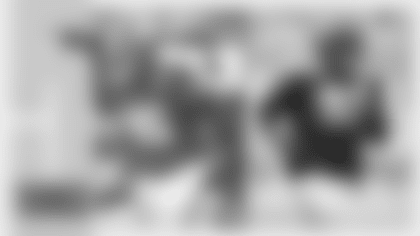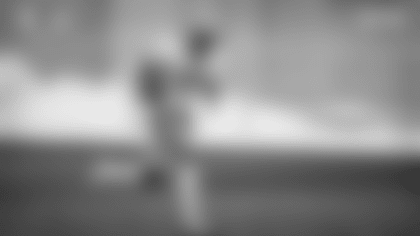The quarterback position is the ultimate need for a team. That's why 24 quarterbacks have been selected first overall since the beginning of the draft.
Of the past nine quarterbacks taken with the top pick, seven have led their respective teams to the playoffs. Cincinnati's Carson Palmer and Houston's David Carr are the only ones who haven't so far (Carr has been in the NFL two years; Palmer has yet to take his first NFL snap). Don't bet against Carr and the Texans making it this year.
Since 1970, four quarterbacks taken with the first overall selection were a starter on teams that won the Super Bowl 11 times. Terry Bradshaw (four) and Troy Aikman (three) were with the same team that drafted them. Also, Jim Plunkett (two) and John Elway (two) were with clubs other than the ones that drafted them.
Remember Super Bowl XXXVIII? Jake Delhomme was an undrafted free agent in his fifth season, and Tom Brady was the 199th player selected in the 2000 NFL Draft. Brady, 26, already has won two Super Bowls.
In the 1958 draft, two quarterbacks were selected from the same school (Rice). The Chicago Cardinals took King Hill with the first overall pick, and the Los Angeles Rams picked Frank Ryan with the No. 55 selection. Hill played 14 years and Ryan played 13 seasons. Two quarterbacks were also selected from the University of Washington in 1993 -- Billy Joe Hobert was a third-round pick of the Raiders and Mark Brunell was a fifth-round choice of the Packers.
Over the past three drafts, quarterbacks drafted in rounds one through four have measured up this way:
The shortest: 5-11 3/8; the lightest: 210; median: 225
The slowest: 5.24; the tallest: 6-5 3/8; median: 6-2 5/8
The heaviest: 245; the fastest: 4.48; median: 4.83
The average quarterback at this year's combine were:
Height: 6-3 3/8
Weight: 230
40 time: 4.88
Vertical jump: 301/2 inches
Long jump: 9-foot-2
Michigan's John Navarre was the tallest at 6-foot-6.
Tulane's J.P. Losman was the fastest at 4.71.
Louisiana Tech's Luke McCown had the top vertical jump at 37 1/2 inches.
Here are my rankings for quarterbacks:
1. Eli Manning, Mississippi (6-43/4, 221)
At the combine, he did not run or work out. At a private workout, he performed only position drills. In high school, he played basketball and baseball, and quarterbacked the football team to the state playoffs twice. At Ole Miss, he redshirted in 1999. In 2000, he played but did not start. He has started the past three years, including a stellar 2003 season -- 3,600 yards, 29 TDs, 10 INTs, 62.4 percent completions. Everyone asks this question: How does he compare to his brother Peyton? [Accuracy (even); arm strength (slight advantage to Eli); athletic ability (slight advantage to Eli); knowledge of game (slight advantage to Peyton); work habits (I don't think it's possible to work harder than Peyton).] Answer to above question: Eli should have a very good NFL career. He did not have a good supporting cast a Mississippi.
2. Philip Rivers, North Carolina State (6-5, 229)
He ran three 40s in 4.99, 4.97 and 4.95, the short shuttle in 4.34 and the three-cone drill in 7.34. He also had a 321/2-inch vertical jump and a 9-foot broad jump. Alabama player of the year in high school; played quarterback and safety. Also played high school basketball. At N.C. State, he became the starter as a true freshman and started every game of his career (51; an NCAA record). He was the ACC player of the year as a freshman in 2000 and had 10 rushing touchdowns in 2002. This is Bernie Kosar with more athletic ability. Understands football; has a feel for pressure; very accurate; outstanding leader; great character. Good -- not great -- arm strength. Passed for 13,485 yards in his career -- the second most in NCAA history. Wolfpack retired his jersey number (17) after season. Married; their daughter Holle will turn 2 in July.
2a. Ben Roethlisberger, Miami, Ohio (6-4 7/8, 241)
Ran two 40s in 4.81 and 4.82, the short shuttle in 4.32 and the three-cone drill in 6.83. He also had a 30-inch vertical jump. In high school, he played wide receiver until his senior year, when he was Ohio's Division One offensive player of the year in 1999. He also played basketball (over 25 points per game) and baseball; in fact, he captained in all three sports. At Miami, he redshirted in 2000, then started the next three years. In 2003, he completed 69.1 percent of his passes for 4,486 yard and 37 touchdowns against 10 interceptions. Outstanding athlete -- has a very strong arm and very good accuracy. Good leader (makes receivers play table tennis to improve hand-eye coordination). Has average release; needs to throw with more touch. Can really throw the deep ball, and on the move. Lots of upside; key to quarterback success is to work hard.
4. J.P. Losman, Tulane (6-21/4, 224)
Ran two 40s in 4.68 and 4.73, but no shuttles. He also had a 33-inch vertical jump and a 9-foot-8 broad jump. He played quarterback in high school and baseball at Tulane. He entered UCLA in the spring of 1999 and transferred to Tulane in the fall. At Tulane, he redshirted in 1999, then played behind Patrick Ramsey (now of the Washington Redskins) in 2000 but started one game. He started on game in 2001, but missed most of the season due to a knee injury he suffered in practice. He started every game in 2002 and 2003, and was a team captain both years. He passed for 3,077 yards and 33 touchdowns against 14 interceptions last season for an undermanned team. An athletic player with good quickness. He gets rid of the ball quickly. A tough player who took a beating in 2003. Very competitive player; will force throws. Brought team back against TCU but was intercepted at the end of the game. Seems arrogant at times. Has talent; needs coaching and veteran influence (Green Bay would be a great place for him).
5. Matt Schaub, Virginia (6-5 5/8, 243)
Ran two 40s in 5.03 and 5.06, the short shuttle in 4.62 and the three-cone drill in 7.65. He also had a 301/2-inch vertical jump and a 9-foot-2 broad jump. In high school, he was a three-year starter at quarterback, a three-year starter on the basketball team and also played baseball. At Virginia, he redshirted in 1999. Played, but did not start, in 2000. Started six games in 2001, then had a great 2002, when he was named ACC player of the year. He led the league in passing and was sixth overall in the nation. In 2003, he injured his shoulder in the first series of the first game and missed the next three contests. Very good accuracy and anticipation; makes very good decisions; smart; works hard (lifts with team); tough competitor; sturdy build. Good -- but not great -- arm. Has the ability to escape the rush. He is a question mark; I think he can start and be a good player.
6. Luke McCown, Louisiana Tech (6-3 7/8, 208)
Ran two 40s in 4.69 and 4.72, the short shuttle in 4.09 and the three-cone drill in 7.10. He also had a 371/2-inch vertical jump and a 10-foot-5 broad jump. He played quarterback and basketball in high school. He comes from a family of quarterbacks -- two brothers played at Division I school. He played as a true freshman in 2000 and started seven games. He had three 400-yard games -- one against Auburn and another against Miami (Fla.) -- and wound up setting four NCAA freshman records. Excellent athlete; has good arm strength. Hard worker who spent five days at the NFL Scouting Combine throwing in drills for all positions. Played for outmanned team, but he threw two touchdown passes in the final 69 seconds to give Tech a stunning victory at Michigan State last September. Takes some chances and makes bad plays. His thin body will get bigger; his father is a big man.
7. John Navarre, Michigan (6-6, 246)
Ran two 40s in 5.15 and 5.22, the short shuttle in 4.46 and the three-cone drill in 7.75. He also had a 261/2-inch vertical jump and an 8-foot-4 broad jump. He was a three-year starter for a high school team that lost only four games. Also played basketball and baseball, and was an outstanding golfer. At Michigan, he redshirted in 1999. In 2000, he started four games and passed for eight touchdowns. He started the past three years and wound up with ;72 career touchdown passes. Good athlete; average speed and foot quickness (was sacked only 13 times during the regular season). Tough-minded player whom Michigan fans blamed for every loss.
8. Josh Harris, Bowling Green (6-11/2, 238)
Ran two 40s in 4.73 and 4.84, the short shuttle in 4.20 and the three-cone drill in 7.03. He also had a 32-inch vertical jump and a 10-foot-3 broad jump. In high school, he was more of a running quarterback; he also returned kicks. In addition, he played basketball and ran track. At Bowling Green, he played as a true freshman in 2000. In 2001, he started four games and also saw some time at running back. He started the past two seasons at quarterback, mostly in the shotgun formation. He has good athletic ability for the position. He has a strong arm and will try to force the ball at times. He did not look accurate at the combine. He has some upside and probably needs to play in NFL Europe.
9. Bradlee Van Pelt, Colorado State (6-21/4, 231)
Ran two 40s in 4.93 and 5.00, the short shuttle in 4.11 and the three-cone drill in 6.89. He also had a 331/2-inch vertical jump and a 9-foot-7 broad jump. He broke records at his high school for running and passing. He also played baseball, basketball and soccer. He started college at Michigan State and played as a true freshman, but left school that spring because the coaches wanted to move him to safety. At CSU, he started started nine games in 2001 and every game when healthy the next two years. Good -- but not great -- arm strength. Tough; strong; will compete. He will make some bad decisions and try to force the ball. He's a great young man to be around and the type of player who finds a way to win.
10. Cody Pickett, Washington (6-31/2, 233)
Ran two 40s in 4.78 and 4.84, the short shuttle in 4.30 and the three-cone drill in 7.19. He also had a 301/2-inch vertical jump and a 9-foot-1 broad jump. In high school, he played football, basketball, golf and was on the rodeo team. At Washington, he played in one game in 1999 before receiving a medical redshirt. He played (no starts) in 2000, then started the next three years. In a stellar 2002 season, he passed for 4,458 yards and 28 touchdowns, but struggled in 2003 while the team encountered some well-publicized problems. Athletic with good movement. Good -- but not great -- arm strength; good release. Inconsistent; did not do well at the Senior bowl. Washington quarterback have a good history of making NFL teams.
11. Jeff Smoker, Michigan State (6-3 1/8, 223)
Ran two 40s in 4.99 and 5.04, the short shuttle in 4.35 and the three-cone drill in 7.65. He also had a 281/2-inch vertical jump and an 8-foot-5 broad jump. H was said to best the best quarterback in Pennsylvania coming of high school. At MSU, he started six games as a true freshman in 2000. He started every game in 2001 and first seven in 2002 before leaving the team with a substance-abuse problem. He started all 13 games in 2003. He is said to be a good person who will work hard. Tough player. Has a good release but with questionable accuracy; not much of a scrambler. Improved a lot this past season (John L. Smith does a good job with quarterbacks).
OTHERS TO WATCH:
Here are some quarterbacks (alphabetical order) who could also be drafted:
1. Casey Clausen, Tennesse (6-31/2, 223)
Started as a true freshman in a very good program.
2. Andy Hall, Delaware (6-2, 220)
Had a very good season for Division I-AA national champion. Has drawn a lot of interest this spring.
3. Craig Krenzel, Ohio State (6-31/2, 228)
Offensive MVP of BCS title game in January 2003. Will beat you with his brain. Did a good job in East-West Shrine Game.
4. Jared Lorenzen, Kentucky (6-31/4, 288)
Very good athlete; strong arm. Was good basketball player in high school. Was Mr. Football in Kentucky his senior year of high school.
5. B.J. Symons, Texas Tech (6-11/2, 210)
Had surgery to fix the ACL in his right knee after the season. Started only one season (2003), but set single-season NCAA records with 5,833 passing yards and 52 touchdown passes.
DID YOU KNOW?
- Of the six quarterbacks in the 2004 Pro Bowl, three were selected in Round 1. The other three were selected after Round 3.
- Three quarterbacks in this draft have fathers played in the NFL:
Josh Harris (Father M.L. played six years with Cincinnati)
Eli Manning (Father Archie played 13 years, 11 with New Orleans)
Bradlee Van Pelt (Father Brad played 13 years, 11 with N.Y. Giants).
Top quarterback prospects that will be seniors in 2004:
Derek Anderson, Oregon State
Timmy Chang, Hawaii
David Greene, Georgia
Kyle Orton, Purdue
Dan Orlovsky, Connecticut
Andrew White, Arizona State
Jason White, Oklahoma (2003 Heisman)
Charles Whitehurst, Clemson
Top quarterback prospects that will be seniors in 2005:
Matt Leinart, Southern California
Aaron Rodgers, California
Brad Smith, Missouri
Previous Gil Brandt position analysis columns:
Gil Brandt was vice president of player personnel for the Dallas Cowboys from 1960-89. He is now in his eighth year as NFL.com's chief personnel guru. (Brandt is of no relation to Packers VP of Player Finance Andrew Brandt.)














